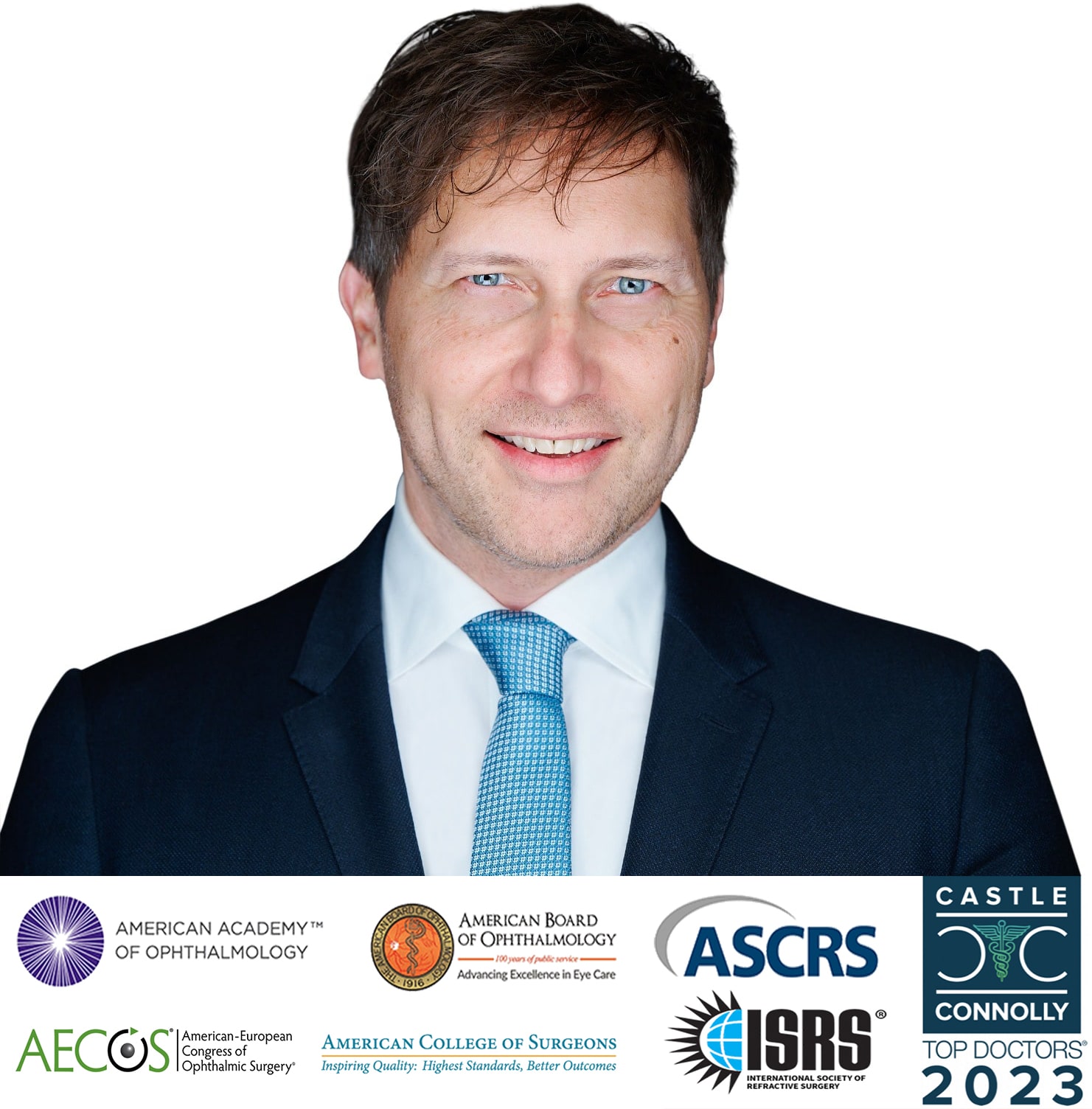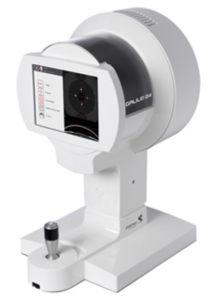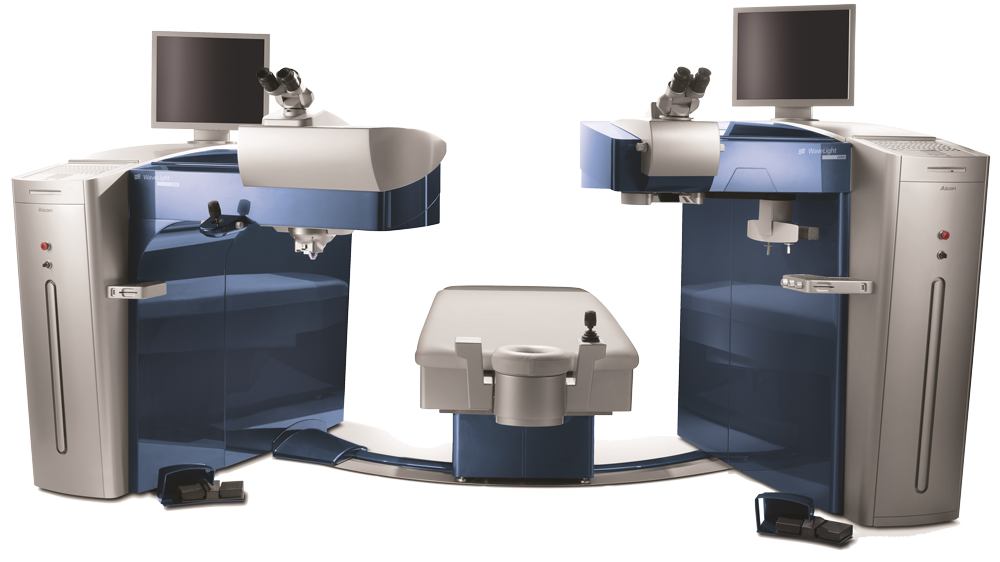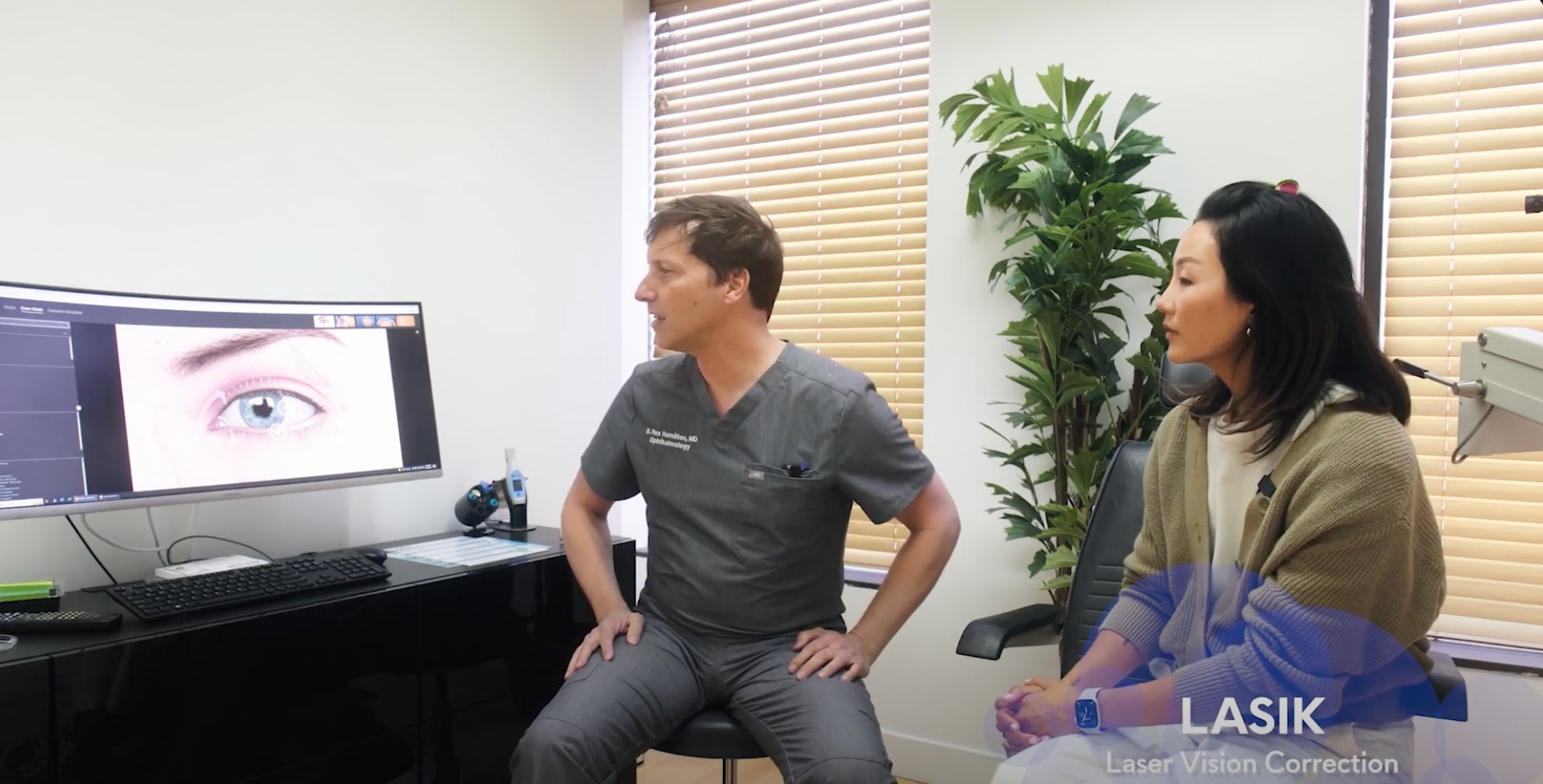LASIK Los Angeles
Meet Dr. Rex Hamilton, M.D.
D. Rex Hamilton, MD, is known throughout the United States and internationally as a leader in laser vision correction (LASIK) and premium cataract surgery. As noted below, he pioneered many new surgical techniques during his 15 years as Professor and Director of the UCLA Laser Refractive Center at the Stein Eye Institute in Los Angeles.
Dr. Hamilton was valedictorian of his high school class. After graduating Phi Beta Kappa and Summa Cum Laude from Dartmouth College with an undergraduate degree in physics and mathematics, Dr. Hamilton earned a Master of Science degree in biomedical engineering at the School of Engineering and Applied Science at the University of Virginia. After working for several years in marketing and product planning for MRI systems at Siemens Medical Systems, Dr. Hamilton decided to pursue a career in medicine. He continued his education at the University of California, Irvine, where he earned a Doctor of Medicine degree and received numerous academic awards and scholarships, culminating in his graduating at the top of his class. He began performing cataract, corneal transplantation, and refractive surgery during his residency training at the UCLA Stein Eye Institute. (read more )


Meet
Dr. Rex Hamilton, M.D.
D. Rex Hamilton, MD, is known throughout the United States and internationally as a leader in laser vision correction and premium cataract surgery. As noted below, he pioneered many new surgical techniques during his 15 years as Professor and Director of the UCLA Laser Refractive Center at the Stein Eye Institute in Los Angeles.
Dr. Hamilton was valedictorian of his high school class. After graduating Phi Beta Kappa and Summa Cum Laude from Dartmouth College with an undergraduate degree in physics and mathematics, Dr. Hamilton earned a Master of Science degree in biomedical engineering at the School of Engineering and Applied Science at the University of Virginia. After working for several years in marketing and product planning for MRI systems at Siemens Medical Systems, Dr. Hamilton decided to pursue a career in medicine. He continued his education at the University of California, Irvine, where he earned a Doctor of Medicine degree and received numerous academic awards and scholarships, culminating in his graduating at the top of his class. He began performing cataract, corneal transplantation, and refractive surgery during his residency training at the UCLA Stein Eye Institute. (read more)
If you are one of many Californians interested in improving your vision, you can learn about LASIK on this website. If you would prefer to speak to someone, simply contact our Los Angeles LASIK office and speak with one of our patient counselors who can provide extensive patient education, explain the process and help arrange financing.
To better understand LASIK, click on the What Is LASIK page where you will find detailed information about the LASIK procedure. An immense amount of new vision correction technology has been introduced over recent years, so we understand that it can be difficult for patients to determine for which procedure they might be best suited. Additional detailed information about LASIK eye surgery can also be found in The LASIK Experience and Advanced LASIK sections where you can learn about the advantages of Custom and Blade-Free LASIK.
LASIK Candidacy
Not every person is a candidate for LASIK eye surgery. We realize that every eye is very unique. No two corneal maps are the same. Each is just as distinctive as DNA or a fingerprint. Visit our LASIK Candidacy page for more information about who may be and may not be a good candidate for laser vision correction. After a preliminary screening visit, a comprehensive eye examination is necessary to make the final candidacy determination. This extensive diagnostic evaluation is the first step in creating a positive outcome to achieve your personal best vision.
$2250 per eye for LASIK or SMILE ! (March Only, Spring Break Special) *
*Restrictions apply
$2250 per eye for LASIK or SMILE! (March Only, Spring Break Special) *
*Restrictions apply
Questions to ask your LASIK eye surgeon BEFORE surgery
- How many vision correction procedures have you performed?
- How many laser vision correction procedures have you performed?
- What type of excimer laser will you be using for my surgery?
- Why did you choose this laser?
- Do I have a good chance at achieving 20/20 vision?
- What happens if I require an enhancement?
- What is your educational background and medical school training?
- What would your colleagues say about you?
- What are my biggest risks with LASIK eye surgery?
- How many patients have you turned away?
LASIK for Nearsightedness
Nearsightedness or Myopia occurs when the eye is long in the front to back direction.
This occurs from birth and typically progresses into the late teens and early twenties. Nearsightedness is characterized by blurry distance vision and excellent near vision without glasses. Nearsightedness is classically treated with glasses or contact lenses.
LASIK is an outstanding option for nearsightedness, particularly for cases of mild and moderate myopia in patients in their 20’s, 30’s and 40’s, providing outstanding vision at all distances without glasses or contact lenses. Higher levels of myopia (e.g. above -9 to -10 diopters) is typically better treated with the EVO Visian ICL procedure. The higher the amount of nearsightedness, the more tissue has to be removed from the cornea during LASIK to flatten its curvature. In situations where a large amount of myopia needs to be corrected, there may not be adequate corneal tissue available to safely perform the correction. Dr. Hamilton will obtain detailed maps of your corneas (corneal topography) during the consultation. These maps provide information on corneal shape and thickness. After reviewing these maps and other tests, Dr. Hamilton will discuss your goals and let you know which procedure is best for your particular situation.
LASIK for Farsightedness
Farsightedness or Hyperopia occurs when the eye is short in the front to back direction. This occurs from birth and is typically characterized by eye strain when observing near objects (e.g. cell phone, reading, putting on make up, computer). The age at which these symptoms appear depends on the amount of farsightedness. Extreme hyperopia can manifest during infancy and early childhood: characterized by eyes that cross. Very mild hyperopia may not manifest itself until the early forties when near vision becomes a strain, particularly in dim light. Most farsighted patients have excellent distance and near vision for the first 3 decades of life. Struggling with near tasks then brings them into the eye doctor where traditionally reading glasses are prescribed.
LASIK is an outstanding option for farsightedness, particularly in cases of moderate and higher hyperopia. Patients who experience eye strain with near work in their 20’s and 30’s benefit significantly from hyperopic LASIK. You can think of the procedure as taking the burden off the natural lens inside the eye which is struggling to focus up close. Patients often report headaches and eye strain after computer work. By reshaping the cornea and making it steeper with LASIK, now the lens inside the eye doesn’t need to strain. It can work much easier over a wider range, to focus on near tasks, lessening eye strain and providing significant relief to the farsighted patient. The natural loss of focusing power of the lens, called presbyopia, will still occur and reading glasses will still be needed in the future. But hyperopic LASIK can be a wonderful solution to relieve eye strain for patients in their 20’s, 30’s and early 40’s. After the mid 40’s, a Refractive Lens Exchange procedure (RLE) may be the better option to correct both near and far vision. Dr. Hamilton will use his expertise during your consultation to make the perfect recommendation for your particular situation.
LASIK for Astigmatism
Astigmatism typically occurs when the cornea (front window of the eye) has an oval or football shape rather than a round or basketball shape. The best optics of the eye occur when light passing through the cornea is focused to a single point on the retina (camera film in back of the eye). Light entering through a round cornea comes to a single point of focus while light entering through an oval cornea comes to a blurred, elongated focus. This elongated focus is perceived as distortion, ghosting and blurred vision at all distances. Astigmatism occurs with either nearsightedness or farsightedness.
LASIK is an outstanding option for astigmatism treatment. The laser is used to reshape the oval shaped cornea into a round shape, improving clarity of vision. Patients with mild and moderate nearsightedness or farsightedness with astigmatism are typically candidates for LASIK. Higher levels of myopia with astigmatism may be better treated with the EVO Visian ICL procedure. After reviewing all of the diagnostic testing at your consultation, Dr. Hamilton will discuss your goals and let you know which procedure is best for your particular situation.
With Rex Hamilton, MD, you will find state of the art technology throughout all aspects of the LASIK experience. Let us walk you through the entire process below, and give you a sense of the most comprehensive LASIK experience available in Los Angeles.
This experience consists of:
- Refractive Surgery Patient Screening
- LASIK Surgical Planning
- LASIK Flap Creation
- Corneal Reshaping
$2250 per eye for LASIK or SMILE ! (March Only, Spring Break Special) *
*Restrictions apply
$2250 per eye for LASIK or SMILE! (March Only, Spring Break Special) *
*Restrictions apply
Common LASIK Questions
- How does the laser work?
- Does it Hurt?
- Are both eyes done at the same time?
- Can LASIK successfully treat nearsightedness, farsightedness, and astigmatism?
- Does insurance cover LASIK eye surgery?
- How long will the surgery take?
- Can I drive home after the surgery?
- How long will I need to take off work?
- Will LASIK interfere with my lifestyle?
- If I have cataracts can LASIK fix this problem?
- How long will the correction last?
The excimer laser uses a cold light beam to sculpt the cornea’s surface to the desired shape by removing a microscopic amount of tissue, correcting nearsightedness, farsightedness and/or astigmatism.
The cornea is easily numbed with eye drops during the procedure. Most patients may experience a pressure sensation for 15 to 20 seconds during the procedure but say they have little to no discomfort both during and after LASIK.
Some patients may prefer to have each eye done on different days. In most cases, however, both eyes are done on the same day. This avoids the period of imbalance that occurs if one eye still needs correction while the other one doesn’t.
Yes, LASIK can successfully treat all three of these vision conditions.
Vision correction surgery is rarely covered by medical insurance. If you have had severe medical problems with your eyes such as corneal transplantation, there is a slight chance that it may be covered. Visit our Patient Financing page for more information on payment options.
We typically ask the patient to arrive one hour prior to the scheduled surgery time to ensure that we have answered all of your questions and to perform any tests required for final surgical planning. The actual surgical time is typically less than 10 minutes per eye.
No, you will need to arrange for a ride home. Because it is likely that you’ll have light sensitivity and some discomfort for 3 -4 hours after your procedure, it is best that you rest at home that evening.
Most patients return to work within one to three days.
Active sports should be postponed for two weeks or until the eye is fully healed, unless protective eyewear is approved by the surgeon. Swimming, hot tubs and saunas should be avoided for three weeks. After a full recovery, normal activity can resume, and the ability to play sports without glasses makes them more enjoyable for many patients.
No, LASIK is not an appropriate surgery for cataracts. LASIK is performed on the front surface (cornea) of the eye. Cataract surgery is the replacement of the cloudy lens inside the eye with an implant. To understand more about lens implant options that can help you see at various distances after cataract surgery, visit our pages on Multifocal and Accommodating IOLs.
LASIK is a permanent procedure. In some cases, an enhancement procedure may be required. Some patients’ eyes may change throughout their lifetime, which can happen with glasses or contact lenses as well.
Refractive Surgery Patient Screening
LASIK surgery with Rex Hamilton, MD, has enjoyed enormous success for more than a decade now due not only to the cutting edge laser technology used during surgery, but also because of the comprehensive screening process utilizing the very latest diagnostic technology to determine your candidacy for LASIK.
GALILEI® G4 (Zeimer)

Rex Hamilton, MD, uses the GALILEI G4 corneal mapping system during the refractive surgery screening process. This amazing tool acquires a detailed, topographical map of the front and back surface of the cornea, the window on the front of the eye. Dr. Hamilton has been using this type of mapping for more than 15 years and has published extensively on the benefits of this advanced technology. It is critical to accurately map both the front and back corneal surfaces to determine the overall health of the cornea. Much like a topographic map identifies areas of elevation for a hiker, the GALILEI system provides a detailed map of elevations and depressions, steep and flat areas, for the both front and back corneal surfaces. In addition, the system measures the corneal thickness across the entire cornea. This information is vital in identifying whether or not the patient’s cornea has enough tissue to safely treat their nearsightedness, farsightedness and astigmatism. A disorder known as keratoconus can exist without a patient being aware they have it. This disorder is characterized by a cornea that is biomechanically weaker than normal. Performing refractive surgery in such a cornea can lead to a worsening of the overall corneal shape, leading to decreased vision. While using the GALILEI G4 to screen patients does not guarantee keratoconus detection, the system has the most advanced algorithms available to detect this abnormality.

Appearance of normal cornea on Galilei maps. Upper right map is of the back surface of the cornea.

Appearance of abnormal cornea on Galilei. Compare the upper right map with that of the normal cornea above. The red “hot spot” identifies an area of protrusion, indicating the cornea is weak and should not undergo LASIK.
$2250 per eye for LASIK or SMILE ! (March Only, Spring Break Special) *
*Restrictions apply
$2250 per eye for LASIK or SMILE! (March Only, Spring Break Special) *
*Restrictions apply
Dr. Hamilton has published a number of studies, including several using the GALILEI system, to help develop these algorithms for early keratoconus detection (see references below).
*B Sonmez, MP Doan, DR Hamilton. Identification of Scanning Slit-Beam Topographic Parameters Important in Distinguishing Normal from Keratoconic Corneal Morphologic Features. American Journal of Ophthalmology 2007; 143(3), 401-8.
*ME Sy, A Ramirez-Miranda, S Zarei-Ghanavati, J Engle, J Danesh, DR Hamilton. Comparison of posterior corneal imaging before and after LASIK using dual rotating scheimpflug and scanning slit-beam corneal tomography systems. Journal of Refractive Surgery 2013; 29(2), 96-101.
LASIK Surgical Planning
Once all your measurements are completed, Dr. Hamilton and his colleagues use a sophisticated software program that analyzes your unique characteristics (e.g. age, gender, amount of correction, environmental conditions, etc.) to determine the optimum laser setting for each of your eyes. Dr. Hamilton and his colleagues presented a paper at the American Society of Cataract and Refractive Surgery meeting describing an advanced nomogram he developed to optimize patient outcomes*. A nomogram is an equation derived using previous patient information to provide the best laser settings for optimized future patient outcomes.
* JB Biebesheimer, DR Hamilton. Development of an advanced nomogram for LASIK surgery (paper). American Society of Cataract and Refractive Surgery Annual Meeting, San Francisco. April 2009.
LASIK Flap Creation
Dr. Hamilton uses the highest quality Laser Visumax-Zeiss!
“The VisuMax® Femtosecond Laser Its remarkable features are its precision and innovative detail. With the VisuMax®, Zeiss is significantly shaping the world of refractive surgery. This groundbreaking laser system employs high-performance femtosecond laser technology and is characterized by its outstanding cutting precision, highly efficient speed and gentle treatment technique”.
The accuracy and predictability of the VisuMax® laser have allowed some patients who were previously ineligible for LASIK to now have the procedure. With the FS laser, unlike with mechanical instruments, your surgeon is able to precisely program the dimensions of your flap (diameter and thickness) based on what’s best for your eye. Dr. Hamilton and his colleagues published a scientific study suggesting the use of a femtosecond laser to create the LASIK flap has a more consistent and predictable effect on corneal biomechanics (i.e. strength) than the use of a microkeratome (blade) system.
Corneal Reshaping
The final step in the LASIK experience is the reshaping of the cornea. An excimer laser is used to precisely remove microscopic amounts of corneal tissue to change the curvature of the cornea. The ideal excimer laser is fast, precisely controlled with advanced eye tracking and comfortable for the patient.

The Eye-Q excimer laser is the fastest laser available in the industry. At 400 Hz, it is 8 times faster than its predecessor. Faster treatment times translate to more consistent and predictable patient outcomes as well as an easier, more comfortable patient experience. With speed comes the responsibility to track the eye precisely to ensure every pulse is placed in the exact, intended location. The Eye-Q eye tracking system is the most robust currently available, reliably locking on to the pupil regardless of eye color or lighting conditions.
Contact one of our staff today to set up your complimentary LASIK evaluation in Los Angeles today!
$2250 per eye for LASIK or SMILE ! (March Only, Spring Break Special) *
*Restrictions apply
$2250 per eye for LASIK or SMILE! (March Only, Spring Break Special) *
*Restrictions apply
LASIK in Los Angeles, CA








